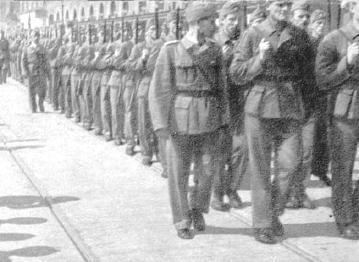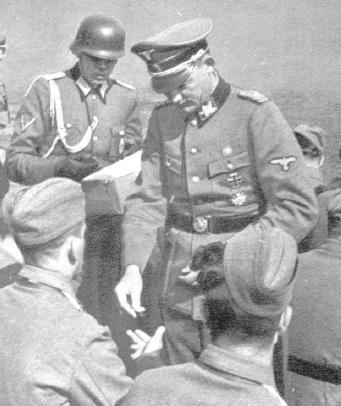Active 1943–1945 | ||
Size about 13,000 at its height (summer 1944) Motto Za Boga, narod in domovino "For God, Nation and Homeland" Similar Croatian Home Guard, Yugoslav Partisans, Ustaše Militia, Black Legion, Russian Corps | ||
The Slovene Home Guard (Slovene: Slovensko domobranstvo; German: Slowenische Landeswehr) was a Slovene military anti-Partisan organization during the 1943-1945 German occupation of the formerly Italian-occupied Province of Ljubljana. It consisted of former Village Sentries (In Slovene: "Vaške straže", in Italian language: "Guardia Civica"), part of Italian-sponsored Anti-Communist Volunteer Militia, re-organized under Nazi command after Italy dropped out of the war.
Contents

It was closely linked to Slovenian right wing anti-Communist political parties and organizations, which provided most of the membership, taking assistance of Germans rather than the opposite. In the Slovenian Littoral, a similar but much smaller unit, called Slovenian National Defense Corps (Slovene: Slovensko narodno varnostni zbor, German: Slowenisches Nationales Schutzkorps), more commonly known as the Littoral Home Guard (Slovene: Primorsko domobranstvo) was ideologically and organizationally linked to the SD. An even smaller Upper Carniolan Self-Defense (Slovene: Gorenjska samozaščita, German: Oberkrainer Landschutz), also known as the Upper Carniolan Home Guard (Slovene: Gorenjsko domobranstvo) was active in the Upper Carniola between 1944 and 1945. All three "home guard" units were formed almost exclusively by ethnic Slovenes. At their peak, they had a combined membership of around 21,000 men, of whom there were 15,000 in the Province of Ljubljana, 3,500 in the Julian March and 2,500 in the Upper Carniola. Its officers and language of command were Slovene.
Background

During World War II, Slovenia was in a unique situation in Europe and only Greece shared its experience of being trisected. However, Slovenia was the only one that experienced a further step—absorption and annexation into neighboring Nazi Germany, Fascist Italy, and Hungary. The Third Reich annexed Lower Styria, Upper Carniola, Slovenian Carinthia, and the Lower Sava Valley, Italy annexed southeast Slovenia with Ljubljana, and Hungary annexed Prekmurje.
Formation
On 24 September 1943, the SD was formed by order of SS General Rösener. German bravery medals were the only medals issued to the members of the SD. An individual member of the SD was a Domobranec, the plural of which was Domobranci. In its aims and ideology, the SD was anti-Partisan and anti-communist.

The Slovene Home Guard (SD) functioned like most collaborationist forces in Axis-occupied Europe during World War II, but had limited autonomy, and at first functioning as an auxiliary police force that assisted the Germans in anti-Partisan actions. Later, it gained more autonomy and conducted most of the anti-Partisan operations in Slovenia, while still having German officers in command. The SD supported their military actions by publishing a regular newspaper and pamphlets.

The majority of the SD forces were infantry, although they also possessed artillery units, which were, however, seldom used. The SD had no armoured units (except for a few armoured trains), even though several tank crews were sent to Germany for training. The SD used Italian equipment (confiscated when Italy dropped out of the war in September 1943), and weapons, uniforms and equipment supplied by the Germans, especially later in the war.
Almost all SD members fled Slovenia and took refuge in the Southern Austrian province of Carinthia at the end of the war (May 1945). Most were returned to Yugoslavia by the British military administration, and many were executed by the new communist authorities. The total number of Domobranci summarily executed in mass executions by the authorities exceeds 11,400.
The Slovenian Government created the Commission on Concealed Mass Graves in Slovenia and documented the mass grave sites of the POWs. They were investigated between November 2005 and October 2009. The POWs units that were not executed were placed in Yugoslav concentration camps.
The summary executions were the first time publicly condemned in an interview that the writer Boris Pahor had with the poet and politician Edvard Kocbek, resulting in a campaign by the Titoist government against both in the "1975 Zaliv Scandal".
Oaths of allegiance
Domobranci swore oaths for allegiance and Slovenian nation at Bežigrad stadium, first on Hitler's birthday, 20 April 1944, and the second time on 30 January 1945, the 12th anniversary of the Nazi takeover of power in Germany. In the first ceremony, the Domobranci from Ljubljana, some other units from the province of Ljubljana, and members of the police corps of the Slovenian Home Guard swore oaths of allegiance. Before the oath, the bishop Gregorij Rožman held a silent mass for the Domobranci, then, according to witnesses, chose to observe from the background despite being offered a place on the main stand, and left quickly afterwards.
During the oath ceremony, the president of the provincial government, Leon Rupnik, and SS general Erwin Rösener made speeches and there were also some guests present, including the honorary consul of the Independent State of Croatia, commissioned officers of the Slovenian Home Guard, the rector of the Slovenian Academy of Sciences and Arts and others. They flew the German and also, for the first time since the beginning of the occupation, the Slovenian flag (which was banned under the Italian occupation), and displayed the coat of arms of Carniola. First they played the Nazi anthem and the Slovenian anthem Naprej zastava slave. After the ceremony Rösener awarded Domobranci medals and wound badges.
The oath was at the insistence of the Germans, upon a threat of the dissolution of the Slovenian Home Guard. By means of the oath, Erwin Rösener wanted to achieve greater discipline among the Domobranci and also put in place a judicial-formal basis, to which he could formally refer when dealing with the Slovenian Home Guard. Despite the date on which the oath was taken and the accompanying scenography, the oath was not one of allegiance to Hitler (unlike the oath of allegiance of the SS), but it provided very useful propaganda for their opponents nonetheless. Many officers, who had already sworn an oath of allegiance to King Peter of Yugoslavia while in the Yugoslavian army, tried more or less successfully to avoid it.
The Littoral and Upper Carniolan units never swore oaths.
Members of the Domobranci and the police force promised that:
Every Domobranec also signed a written statement in German and Slovene that:
Aftermath of World War II
After the end of the war, when Tito's victorious forces took revenge on their real and perceived enemies that were sent back to Yugoslavia from Carinthian refugee camps by the British military administration, the majority were murdered in summary executions by the Yugoslav People's Army and buried in concealed mass graves in Slovenia, first talked about publicly by Slovene writers Edvard Kocbek and Boris Pahor in the 1975 Zaliv Scandal.
